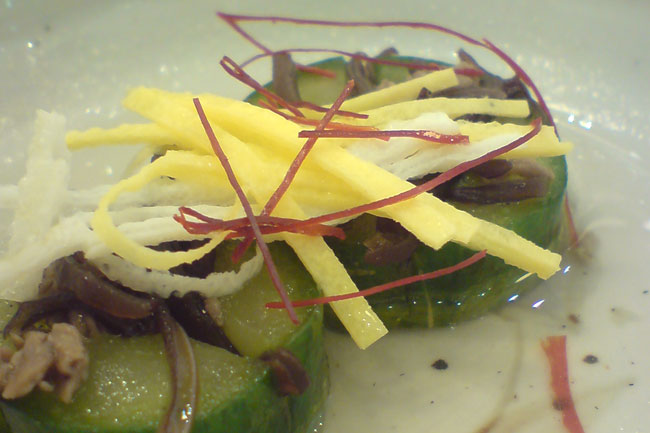- Seon (food)
Infobox Korean name

caption="Oiseon", made with cucumber and meat.
hangul=선
hanja=linktext|膳
rr=Seon
mr=Son"Seon" refers to
Korean traditional dish es made bysteaming vegetables such aszucchini s,cucumber s,eggplant s, orNapa cabbage s that are stuffed withfilling s. Although the term is a counterpart of "jjim ", dishes made by steamingmeat orseafood , the concept is not clearly settled.cite web|url=http://100.empas.com/dicsearch/pentry.html?s=K&i=242482&v=43 |title=Seon (선 膳) |publisher=EncyKorea |accessdate=2008-05-27 |language=Korean] To make a "hobakseon" (호박선) or "oiseon" (오이선), a zucchini or cucumber is cut to pieces of 4 or 5 cm in length and slit in a quarter. The pieces are briefly salted and the juice is squeezed a little. Beef or chicken and onions are chopped and mixed together with seasonings to make fillings. The prepared pieces of the zucchini or cucumber are stuffed with the fillings and placed on a pot. Seasoned stock or vegetable broth is poured over the ingredients till soaked and boiled or steamed for 5 or 10 minutes. After finished the cooking, slices of "seogi" (석이, "Umbilicaria esculenta "), chili peppers, and "jidan" (지단, fried eggs separated into white and yellow layers) are placed on the dish as "gomyeong" (고명, garnishes). [cite web|url=http://english.triptokorea.com/english/viewtopic.php?t=4186&sid=7bd9ae2b2bc461f992ea5ed441c069e0 |title=Oiseon |publisher=triptokorea.com |language=English] [cite web|url=http://english.triptokorea.com/english/viewtopic.php?t=4106# |title=Hobakseon |publisher=triptokorea.com |language=English] Besides the dish, "gajiseon" (가지선, steamed eggplant), "gochuseon" (고추선, steamedchili pepper ), "donggwaseon" (동과선, steamedwinter melon ), "museon" (무선, steameddaikon ), "baechuseon" (steamednapa cabbage ) and "dubuseon" (steamedtofu ) are representative of "seon" dishes.In historical cookbooks
According to a
cookbook titled "Eumsik dimibang" (음식디미방) written during the midJoseon Dynasty , the historic recipe of "donggwaseon" (동과선), a variety of "seon" dishes made with "dongga" (winter melon ) is very different from the modern one. Thick slices of a winter melon are lightlyparboil ed in water and then along with oil are put into a bowl of the boiled mixture of "ganjang " and water. After the sauce is discarded, a new bowl of boiled "ganjang" mixed with mincedginger is poured over the vegetables. "Donggwaseon" is preserved and is eaten with vinegar spread over it.In "
Siui jeonseo ", a cookbook written in the late 19th century, a recipe of "hobakseon" (호박선, zucchini "seon") is similar to the modern seon dishes. A zucchini is hollowed out and filled with various condiments and steamed. A sauce made with vinegar,ganjang andhoney is poured over the cooked dish and slicedchili pepper , "seogi" (석이Umbilicaria esculenta ), and "jidan" (fried eggs) are place on the zucchini and groundpine nut s are spread over it.However, the term did not have its modern meaning as late as the 1930s; cookbooks written at that time use the term very differently--they refer to "cheongeoseon" (청어선, steamed
herring with fillings), "yangseon" (양선, steamed and stuffed beef intestine), or "dalgyalseon" (달걀선, steamed eggs). At present, the term is generally limited to stuffed vegetable dishes.Gallery
ee also
*
Jjim
*Bokkeum
*Stuffed peppers
*Mandu (dumpling)
*Korean cuisine References
External links
* [http://seattletimes.nwsource.com/html/foodwine/2002718659_case04.html Oiseon recipe] at the Seattle Times
*ko [http://www.casa.co.kr/media/article_view.jsp?class1=RC&class3=RCCK03&articleCd=RCCK03000147 Dobuseon recipe] at casa.co.kr
Wikimedia Foundation. 2010.
